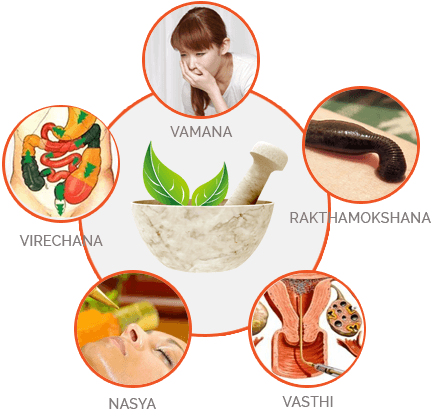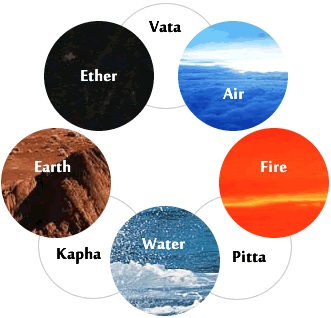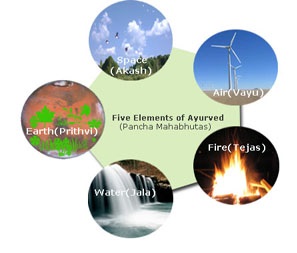
Ayurveda, which literally means the Science of life. Ayur means life Veda means science or Knowledge. Ayurveda is the traditional healing system of India. Often called the mother of all healing, it originated in India over 5000 years ago.
Ayurvedic medicines are made of various herbal extracts like plants, roots, tree’s etc. Your inner nature is called your constitution or prakruti and is an individual blend of the three doshas, Vata, Pitta, and Kapha. The unique balance of these three keeps a person healthy. It is their imbalance which causes disease. The disease is caused because of toxins created in the body over a period of time because of imbalanced diet, environment pollution etc.
About Panchakarma
This five-fold purification therapy which aims at correcting the imbalance of the body’s Doshas or bio energies (Vata, Pitta and Kapha) in order to maintain their inherent equilibrium and Ama, which forms as a result. Panchakarma treatments has three main stages: Poorvakarma, Pradhanakarma
Poorvakarma , the first stage, comprises essential preliminary procedures for preparing the body to unload stored toxins. The Panchakarma treatments help to loosen Ama (toxins) and move it out to the deep structures into the gastro-intestinal tract, where Panchakarma’s cleaning therapies can then eliminate it.
Pradhanakarma is the second stage and includes the main cleansing therapies. which involves procedures like Vamana, Virechana, Nasyam, Vasthi
Paschatakarma is the final stage and describes the measures employed after the main treatment, such as diet, medicines and daily routine.

Treatment of Chronic Ailments through Ayurvedic Panchakarma Therapies
Facts you should know while undergoing treatments for various chronic ailments like, Joint pains, Slip disc, Spondilitis, Arthritis, Paralysis, Psoriasis, Diabetes, Migraine, Sinusitis, Asthma, Frozen disc, Back pain, Sciatica, Infertility, Nervous disorders, Gynaec Problems, Sexual problems, Pediatric Problems etc. through Ayurvedic Panchakarma Therapies are as follows :
The fundamental principles of Ayurveda, like those of other Asian traditions are based on the notion that all matter is thought to be composed of five basic elements (panchamahabhutas) which exhibit the properties of earth (prithvi), water (jala), fire (tejas), wind (vayu) and space (akasha). These elements do not exist in isolated forms, but always in a combination, in which one or more elements dominate. According to Ayurveda, the human body is composed of derivatives of the five basic elements, in the form of humors (Doshas), tissues (Dhatus) and waste products (Malas).
The characteristic principle of Ayurveda is the tri-Dosha system, the Three Humors. The physiological constitution of the body is the manifestation of the ‘quantity’ of the three Doshas. They are vata, pitta and kapha. Vata regulates movement and is represented by the nervous system. Pitta is the principle of biotransformation and is the cause of all metabolic processes in the body. Kapha is the principle of cohesion and functions through the body fluids. The basic physical form is determined by the balance of the three Doshas in what is called Prakruti, or physical nature.
Under normal conditions, the Doshas, Dhatus and Malas correspond to certain standards regarding their quantity, quality and function. However, this situation is not static, and due to several endogenous and erogenous factors, the doshas may become unbalanced, resulting in disease. Every disease is related respectively to a specific imbalance of the Doshas. Other coherent factors can be: the disturbance of the biological factors (agnis), the formation and accumulation of undigested nutrients (ama / toxins), obstruction of the body channels (shrotorodha), and a disturbed assimilation in the tissues.
Ayurveda gives us a model to look at each individual as a unique makeup of the three Doshas (Prakruti) and thereby design treatment protocols that specifically address a person’s health challenges. When any of the Doshas (Vata, Pitta or Kapha) become aggravated, Ayurveda will suggest specific lifestyle and nutritional guidelines to assist the individual in stimulating or pacifying the imbalanced Doshas. If toxins in the body are abundant, then a cleansing process known as

There are three phases of Panchakarma: The preliminary therapies, called Purvakarma ; the five main therapies of Panchakarma (vamana, nasya, virechan, raktamokshana, and vasti); and post-treatment procedures called Paschatkarma . Both pre- and post-panchakarma therapies are essential to the success and long lasting effects of the Panchakarma program.
Purvakarma therapies serve to prepare the body to get rid of stored ama (toxins). Snehana (oleation) is the first step of purvakarma. It consists of saturating the body with herbal or medicated oils. Abyantar snehana, or internal oleation with ghee or medicated oil, helps loosen ama (toxins) and move it from deeper tissues into the gastrointestinal tract where panchakarma’s main therapies can eliminate it. External oleation is called Abhyanga (or bahya snehana). It consists of vigorous massage over the whole body with medicated oils. The choice of oils depends on the particular needs and doshic imbalance of the individual.
The basic idea behind the function of purvakarma therapies can be understood with the following analogy. Suppose you oil a bowl thoroughly and then pour honey into it. The honey cannot stick to the bowl because the slippery quality of the oil does not allow it to. Ama (toxins) has the same sticky quality as honey, and moves easily after the body has been thoroughly oiled and relaxed with purvakarma therapies.

After purvakarma therapies have been performed, ama (toxins) is back in the gastrointestinal tract and can be removed from it with the main panchakarma therapies: Vamana, nasya, virechan, raktamokshana, and vasti. Each of these therapies promote the removal of ama through the normal channels of elimination, either moving it upward, downward or through the periphery (skin). The Ayurvedic clinician will assess the imbalances and decide which therapies should be emphasized, depending on which doshas, tissues and organs are involved and where ama has lodged in the body.
The Benefits of Panchakarma
Panchakarma (five actions) is a cleansing and rejuvenating program for the body, mind and soul. It is known for its beneficial effects on overall health, wellness and self-healing. You can benefit in the following ways:
- Eliminate toxins and toxic conditions from your body and mind
- Restore your constitutional balance improving health and wellness
- Strengthen your immune system and become more resistant to illness
- Reverse the negative effects of stress on your body and mind
- Slow the aging process
- Enhance your self-reliance, strength, energy, vitality and mental clarity
- Bring about deep relaxation and a sense of well-being
- Reduce dependence on drugs and medicine
- Implement positive lifestyle changes


